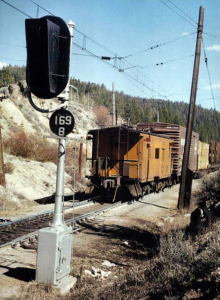
Eastbound just exited Tunnel #11 atop the Continental Divide – Pipestone Pass. We recently discussed the train whistles, and to a short extent the signal calls. Two longs, a short followed by another long is a highway grade crossing warning. Three longs alert the whole train crew the intent to put the train in a reverse movement. Switchmen and brakemen on the ground would usually communicate by hand signal, or by kerosene lanterns in darkness, and respond to whistle signals as appropriate. Widespread railroad radio communications only goes back to the 40s & 50s.
When a train made an unscheduled stop out on the mainline, for any reason, a flagman was dispatched from the caboose. He was equipped with a flag, lantern, fusee (flares) and track torpedoes. It was up to him to make the train secure from any following movement. How far to the rear was dictated by the highest speed allowed on that track segment.
Upon removal of the cause for the delay, the engineer would “whistle-in” the flagman. After waiting for a reasonable time the train would slowly get underway, assuming the flagman recovered from his position and was aboard the caboose.
There were instances where the flagman may not hear the call; canyons, heavy tree foliage, unrelated noise, like highways, waterfalls, storm conditions, etc., even other trains, like across the river. More than one flagman got left behind. A good Conductor would not let that happen. His method to prevent abandonment was to open the air-brake valve and disallow the brakes from releasing. The engineer would know what is happening by the lack of air-pressure building in the train-line.*
Getting left behind up in the mountains or out in the desert had to be on the mind of that lonely flagman. I guess worse than that would be stranded adjacent to an alligator-filled Southern swamp, in the middle of the night. I don’t think they paid these guys enough.
* A discussion on air-brakes may be in order, for another day. Notice the Milwaukee Road used “Bay-window cabeese.” Photo credit: Tom Post, David P. Oroszi collection, May 1973, fourteen months prior to wires coming down. (rear cover The Milwaukee Railroader mag. 2nd Qtr. 2014) – Gary O. Ostlund
